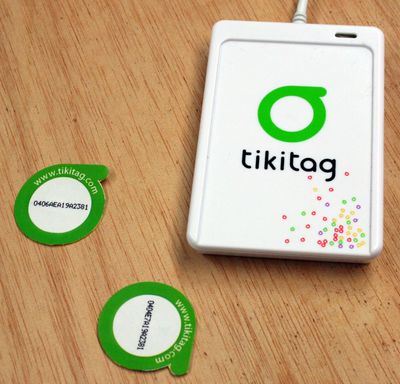Alcatel-Lucent Ventures, the new-product incubator of Bell Labs, the research arm of telecommunications firm Alcatel-Lucent, is rolling out a new RFID-based consumer product called tikitag.
The company introduced the tikitag RFID tag and interrogator on Monday at DEMOfall 08, a conference showcasing new technologies, in San Diego. The passive 13.56 MHz tag, embedded in an adhesive label or sticker, is compliant with the Near Field Communications (NFC) protocol; the reader is a small device that plugs into a computer’s USB port. The idea behind the offering is that consumers will employ the interrogator to read a unique ID encoded to each tag and associate it with online content, such as a URL, or with an online application. By reading the tag, the tikitag reader can bridge the physical tag with the virtual world.
Say, for example, you receive a framed family photograph as a gift from your aunt. You could adhere a tikitag label to the photo, then use the reader and the tikitag application running on your computer to encode a unique ID to the tag that would direct your computer’s Web browser to, for instance, your cousin’s blog containing her research into your family’s genealogy. Thereafter, anytime you wanted to see recent discoveries she’d made regarding your family’s immigration to the United States, you could just hold the photograph to the tikitag interrogator at your desk.
Because the tikitag system is manufactured in compliance with the NFC standards developed by the NFC Forum (of which Alcatel-Lucent is a member), the tags can be read by other NFC interrogators as well, including NFC-enabled cell phones. Nokia currently sells one NFC-enabled handset in the United States and soon plans to add the functionality to other models. Handset manufacturers Motorola and Samsung have also developed prototypical NFC handsets that have been used in NFC pilot programs in this country.
Alcatel-Lucent Ventures is launching tikitag with an eye toward analysts’ predictions of a strong uptake of NFC phones in the coming years—ABI Research estimates that more than 20 percent of all cell phones utilized in the United States will be NFC-enabled by 2012. “We see a huge increase in [NFC phone availability] in the coming three to four years, and that will fit quite nicely with our [tikitag] system,” says Paul Ross, Bell Labs’ director of corporate communications. By launching the tikitag service, Alcatel-Lucent hopes to emerge as a leader in RFID-based consumer applications.
Initially, current NFC phone users will be able to read a tikitag that is associated with a particular URL, in order to visit that Web site without having to type in its address. An art gallery, for instance, could mount a tikitag on a wall next to a series of paintings. Reading the tag with a mobile phone might trigger the device to launch the artist’s Web site. Alcatel-Lucent is presently working on a tikitag client that consumers will be able to load onto their mobile phones, enabling them to run specific applications on those phones. At first, however, this client will be available only for desktop or laptop users.
One such application involves utilizing the tikitag as a “social business card.” The user creates a Web site containing his or her social network settings. That person can then later present the tag to another individual, who can read the tag and be automatically linked to the user through whatever social networks they are both members of—such as LinkedIn, Facebook or Twitter.
Another application can allow a user to direct his computer’s iTunes program to play certain play lists or movies, or to perform such actions as skipping a song or pausing, by using the tikitag’s USB interrogator to read tags linked to those play lists, movies or actions.
The brain of the tikitag system is the Application Correlation Server (ACS), which is Web-based. When a tikitag interrogator or NFC phone reads a tag, it transmits that tag’s ID to the server, which stores and manages a database linking the tikitag tag ID and the corresponding action that tag is set to instigate—such as opening a specific Web site or application.
The tikitag labels and interrogators are currently being alpha-tested by Alcatel-Lucent employees and associates, but will be made available to the general public as beta products beginning Oct. 1. As of that date, a starter kit containing 10 tags, the USB reader and access to the ACS will be available through a number of third-party e-commerce sites, including Amazon.com.
According to Ross, as with all products and services created by Alcatel-Lucent Ventures, the tikitag system was developed so it might eventually be transitioned into a commercial product offered by a separate Alcatel-Lucent division. But what is unique about tikitag is that the platform will likely lead to many application ideas among the Web developers—and that is something Alcatel-Lucent hopes to see happen. For that reason, the firm is encouraging others to solicit application ideas on the tikitag Web site, and is also planning to make APIs available to developers in order to foster new applications. “This is one way that they [Alcatel-Lucent] could monetize tikitags,” he says.
In addition to the consumer applications noted above, Alcatel-Lucent Ventures also plans to market the tikitag system to businesses. Potential business applications include employing the tags to create smart posters, so that consumers could download coupons, directional information or advertisements, or using tags attached to products to trigger warranty or registration applications.
In 2006, HP Labs announced a somewhat similar but prototypical product known as Memory Tags, which operated at 2.45 GHz and would require that consumers purchase a specialized reader to encode or read the tags (see HP Spots New Opportunities for Passive RFID). The Memory Tags would also contain a large amount of user memory, whereas tikitags are designed to hold only a unique ID. A call placed to HP to inquire about the status of the Memory Tags was not returned before press time.


